Understanding SEO fundamentals is essential for anyone trying to succeed in digital marketing. Search Engine Optimization, or SEO, is more than just increasing your website’s visibility; it’s also about understanding the tactics that ensure your site performs well in search engine rankings.
This guide delves into the fundamentals of SEO, equipping newcomers with the information needed to navigate the complicated digital landscape.
What is SEO?
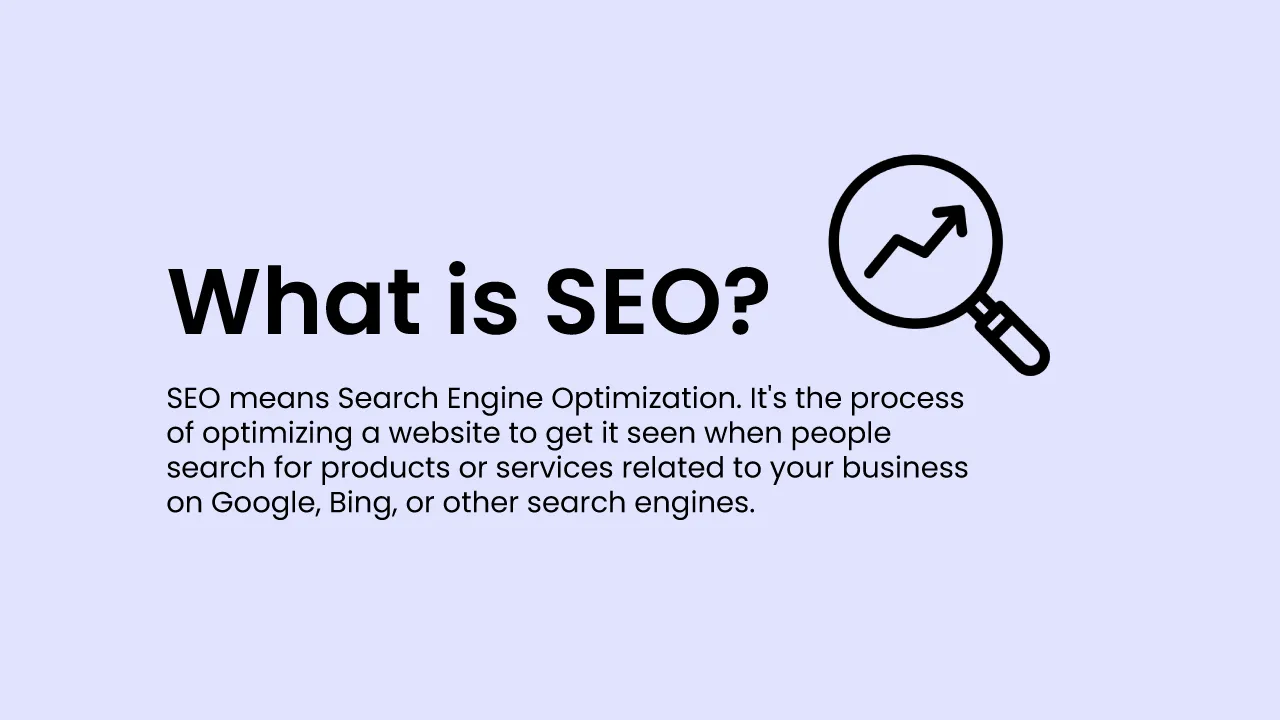
Search Engine Optimization (SEO) refers to the practice of optimizing a website or content to increase its visibility and ranking on search engine results pages (SERPs). The goal of SEO is to make content more accessible to search engines and more appealing to users, thus driving more organic (non-paid) traffic to a site.
SEO has progressed significantly since the beginning. Initially, SEO consisted of keyword stuffing and basic link building. Over time, search engines such as Google began to prioritize user experience, content quality, and relevancy, resulting in increasingly advanced algorithms and SEO methods.
Why SEO Matters
Effective SEO improves a website’s ranking on search engine results pages (SERPs), increasing its visibility to users. Higher visibility often leads to more organic traffic and greater opportunities for conversion. So, we can say SEO matters because:
- Increased Traffic: Higher rankings lead to more visitors.
- Cost-Effective Marketing: Organic traffic reduces the need for paid advertising.
- Brand Authority: High rankings establish credibility and trust.
- Better User Experience: SEO involves improving site usability and speed.
Understanding Search Engines
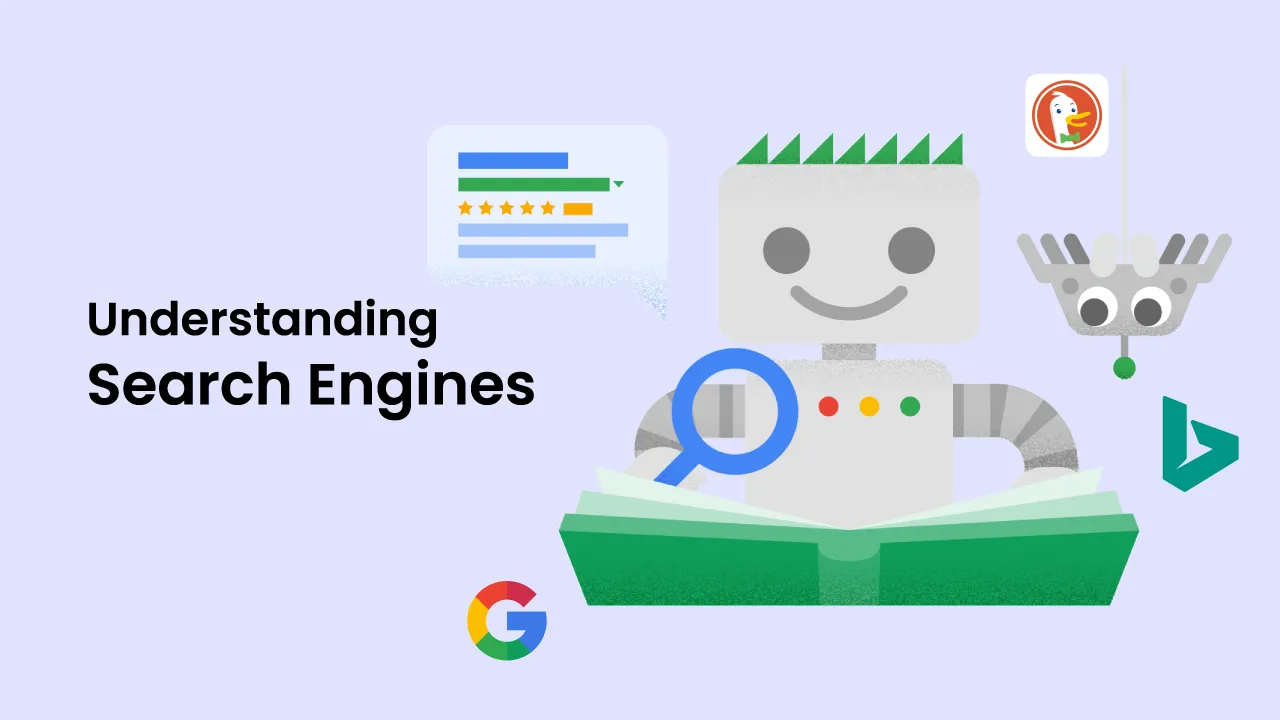
Search engines are web-based tools designed to help users find information across the internet by entering keywords or phrases. They work by crawling, indexing, and ranking content from millions of websites to deliver relevant results based on user queries. Here is an overview of key search engines:
Google dominates the global search engine market with its powerful algorithms and vast resources. It is known for delivering fast, relevant results while personalizing searches based on user behavior and location. Its integration with various Google services makes it a seamless experience for users, enhancing productivity and access to information.
Here are some features of Google search engine:
- Personalized search based on user data and behavior.
- Integration with other Google services (Gmail, YouTube, etc.).
- Advanced AI and machine learning algorithms.
- Google Knowledge Graph for quick answers.
Bing
Bing, owned by Microsoft, is the second-largest search engine. It emphasizes visual appeal, particularly in image and video searches. Bing integrates well with the Microsoft ecosystem and offers unique features like a rewards system, making it a strong alternative for users seeking multimedia searches or those within the Microsoft environment.
Some key features of bing:
- Visually enhanced image and video search results.
- Integration with Microsoft services (Outlook, Office 365, etc.).
- Bing Rewards for frequent searches.
- Comprehensive travel and shopping features.
- Enhanced multimedia search capabilities.
Yahoo
Yahoo, though less popular today, still maintains a presence in the search market. Powered by Bing, it combines search capabilities with other services like Yahoo Mail, Yahoo Finance, and Yahoo Answers. Its status as a major online portal makes it valuable for users who rely on its diverse offerings for entertainment, news, and finance.
Key features:
- Powered by Bing’s search technology.
- Offers Yahoo Answers and Yahoo Finance.
- Integration with Yahoo’s news and entertainment services.
- Email and news portal features.
Other search engines
DuckDuckGo is a privacy-focused search engine, offering an alternative to Google and Bing by not tracking user data or personalizing search results. Known for its commitment to user anonymity, it provides instant answers sourced from over 400 trusted websites, maintaining a clean and simple user interface. DuckDuckGo appeals to privacy-conscious users who prioritize anonymity while searching online.
Ecosia is an eco-friendly search engine powered by Bing that uses a portion of its revenue to fund tree-planting initiatives. With its transparent reporting and environmental mission, it attracts users who are concerned about sustainability and want to make a positive impact on the planet through their web searches.
How Google Search Engines Work
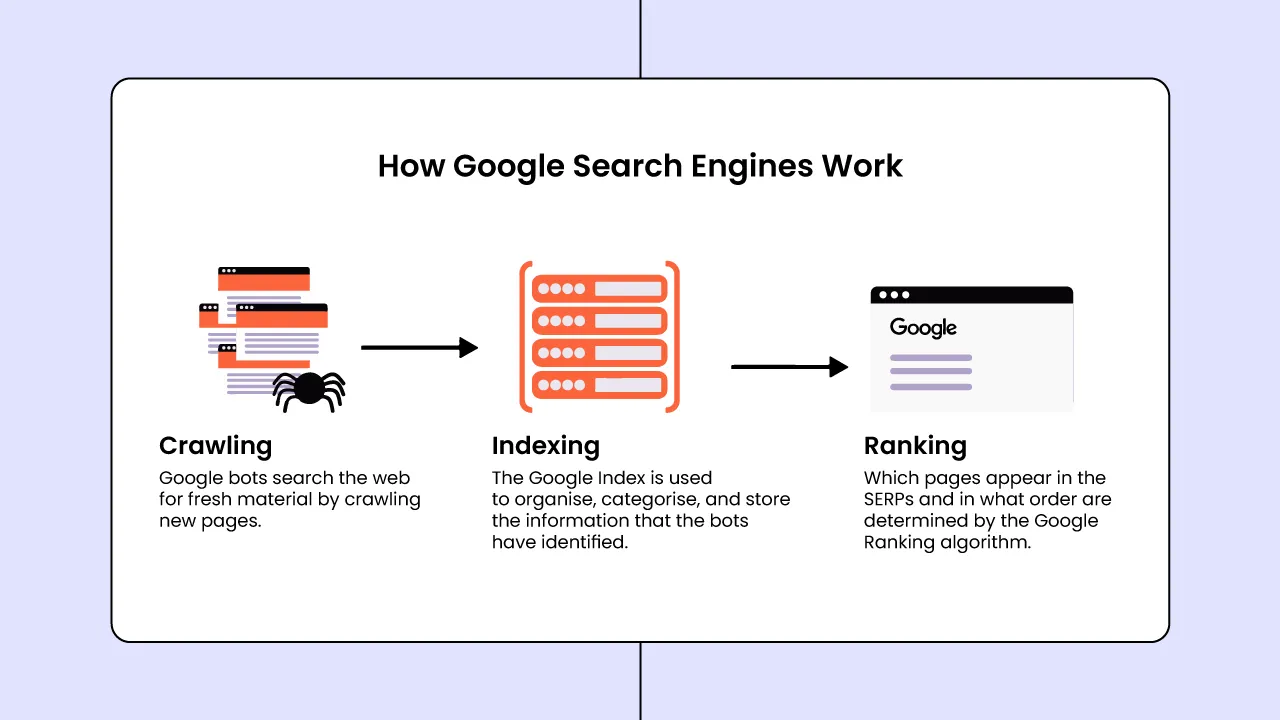
Google’s search engine operates in three major stages: crawling, indexing, and ranking. Sophisticated algorithms support these steps, allowing users to receive the most relevant and accurate results. Here’s a breakdown of how everything works:
Crawling
Crawling is how Google discovers new and updated pages on the internet. It collects information about pages by using automated programs known as “Googlebots” or “spiders” that follow links from one page to the next.
Google Bots crawl the internet, visiting websites, reviewing their content, and discovering links to new pages. The goal is to create an accurate representation of the web’s content. If a website is not linked to other pages or does not have a sitemap, it may not be crawled properly.
Indexing
Indexing is the process of storing and organizing scraped content in Google’s massive database so that it is searchable in the future.
After crawling, a page’s content is examined to determine what it is about. Google examines the text, metadata (e.g., title tags, descriptions), and other elements such as photos and videos. It then classifies the page in its index according to its content and relevance to various search queries. Pages that are well-structured and hold to SEO best practices are more likely to be indexed effectively.
Ranking
Ranking is the mechanism by which Google determines how pages appear in search results for a specific query.
When a user enters a search query, Google’s algorithms assess and rank the indexed pages based on relevancy, quality, and authority. Pages that are deemed most related to the search query will appear at the top of the search results. Keyword utilization, user experience, mobile friendliness, backlinks, and other factors all have an impact on rankings.
Role of algorithms
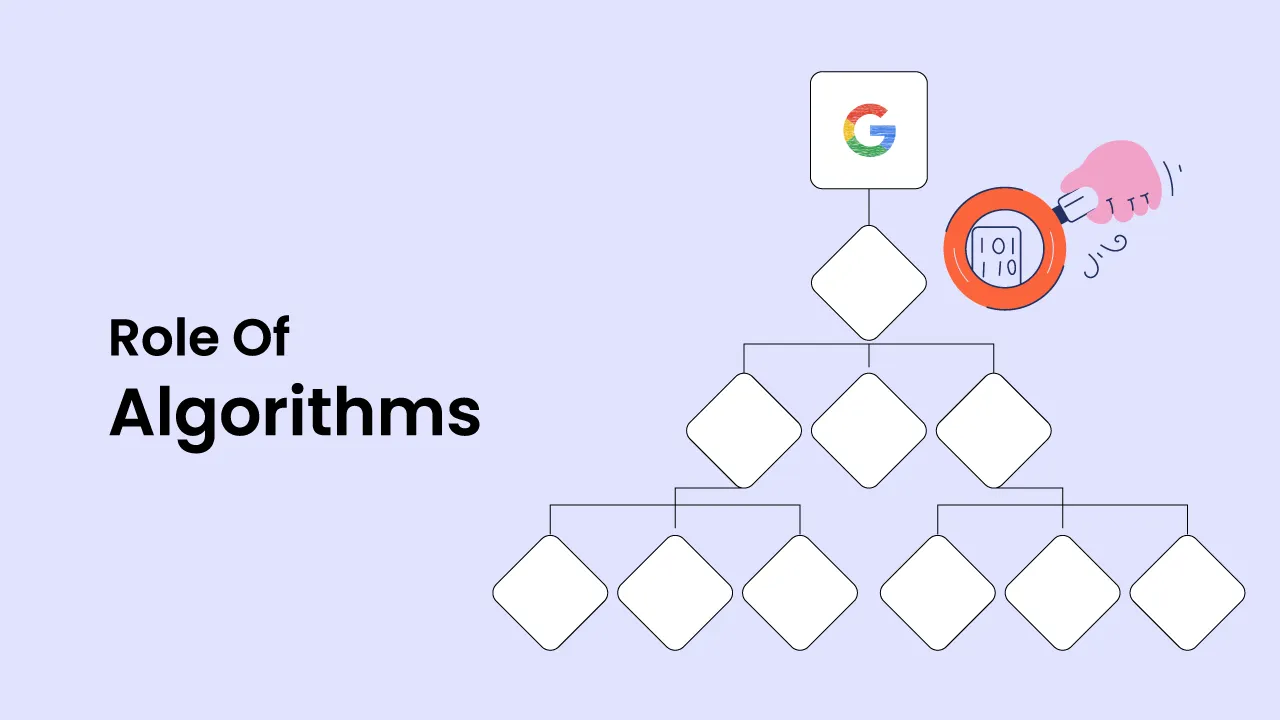
Google’s search algorithms are the backbone of how search results are ranked. These algorithms use hundreds of factors to evaluate and rank pages, ensuring that the most relevant and high-quality content appears at the top of search results. Key algorithms include:
- PageRank: Evaluates the quality and quantity of backlinks to determine a page’s authority.
- BERT (Bidirectional Encoder Representations from Transformers): Helps Google understand the context of words in a query, improving natural language understanding.
- RankBrain: Uses machine learning to better understand complex or unfamiliar queries.
- Hummingbird: Focuses on semantic search and user intent, rather than just matching keywords.
Keyword Research
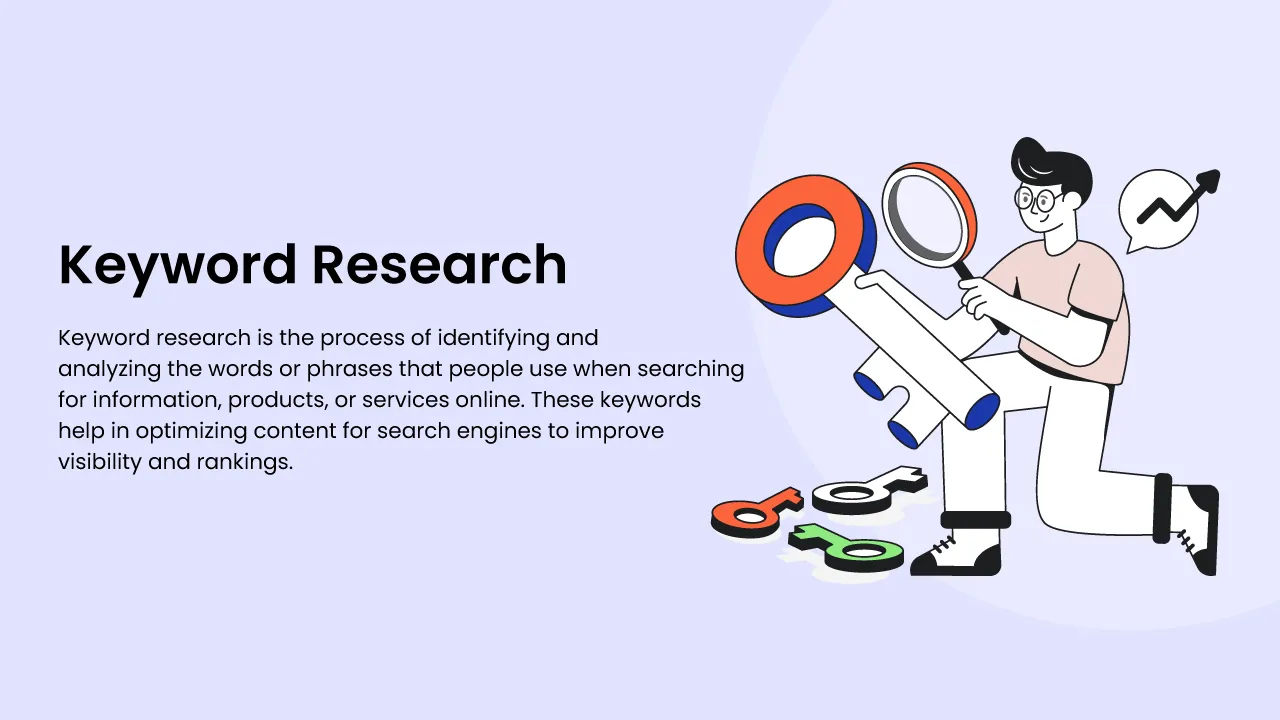
Keyword research is the process of identifying and analyzing the words or phrases that people use when searching for information, products, or services online. These keywords help in optimizing content for search engines to improve visibility and rankings.
What are keywords?
Keywords are specific words or phrases that describe the main topic of a webpage or piece of content. When users enter these keywords into search engines, they are trying to find content that matches their query.
By incorporating relevant keywords into your content, you increase the likelihood of your page being displayed in search engine results when users search for those terms.
Types of keywords
Keywords can be classified into many categories to improve search engine optimization. Some are broad and attract a lot of traffic, while others are more narrow, focusing on niche audiences with less competition. Some phrases refer to a certain brand or product, but others are more generic and appeal to a broader audience. There are additional keywords intended for consumers who are about to make a purchase, as well as those looking for information or attempting to find a specific website. Furthermore, certain keywords incorporate location information, which helps attract local customers. Understanding these categories allows you to better tailor your content to varied user goals. The most three common types of keyword is:
Short Tail
Short-tail keywords are broad search terms that typically consist of one or two words, such as “shoes” or “marketing.” These keywords have high search volumes, meaning a large number of people are searching for them. However, because they are so general, they also tend to be highly competitive, making it difficult to rank highly in search results for these terms. While short-tail keywords can drive a lot of traffic, the search intent behind them is often unclear, as users may be looking for a wide range of information or products.
Long Tail
Long-tail keywords are more specific search phrases that usually contain three or more words, such as “best running shoes for marathon training” or “digital marketing strategies for small businesses.” While these keywords have lower search volumes compared to short-tail keywords, they are less competitive and target a more defined audience. Long-tail keywords often reflect more specific search intent, which means users searching for them are closer to making a decision, resulting in higher conversion rates and more relevant traffic.
LSI
LSI (Latent Semantic Indexing) keywords are words or phrases that are closely related to the main keyword and help search engines understand the context of your content. For example, if the main keyword is “Apple,” related LSI keywords might include “iPhone,” “MacBook,” or “fruit,” depending on the subject of the content. By using LSI keywords, you can enhance the relevance of your content, avoid keyword stuffing, and improve your chances of ranking for a variety of related search terms, making your content more comprehensive and useful for search engines and users alike.
Tools for Keyword Research
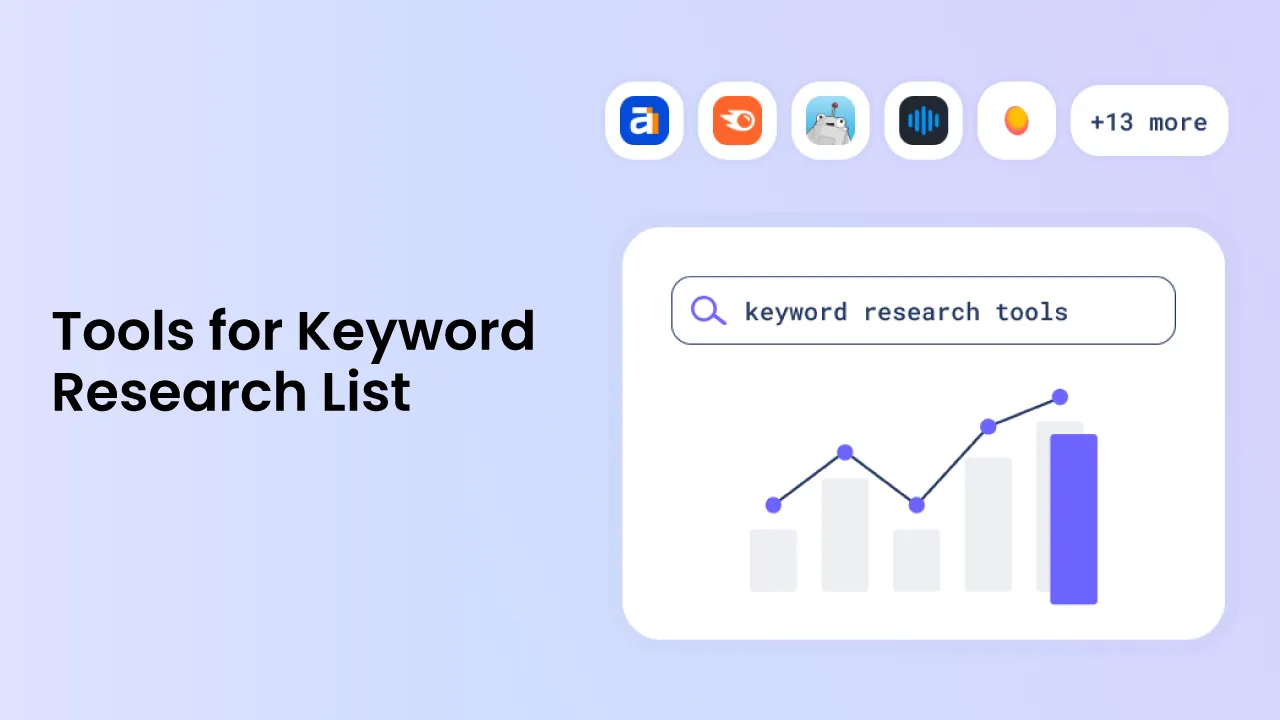
Keyword research tools are essential for improving SEO and digital marketing strategies. These tools help businesses identify relevant keywords to optimize content, increase search engine rankings, and drive more traffic to their websites. Followings are some famous tools:
Google Keyword Planner
A free tool by Google Ads, primarily for advertisers, but useful for SEO. It helps you discover keyword ideas and get estimates on search volumes, cost-per-click (CPC), and competition level for Google Ads.
SEMrush
A comprehensive SEO and marketing toolkit. Its keyword research feature provides data on keyword search volumes, trends, difficulty, and competitive analysis. It also offers keyword gap analysis to compare your site’s keywords with competitors.
Ahrefs
A powerful SEO tool with a focus on backlink analysis and keyword research. Its keyword explorer feature provides detailed insights like search volume, keyword difficulty, clicks, and SERP analysis to help target high-potential keywords.
Ubersuggest
A free and user-friendly tool from Neil Patel. It offers keyword suggestions, search volume, CPC, keyword difficulty, and content ideas. It also shows SEO competitor analysis and backlink data.
Strategies for Finding the Right Keywords
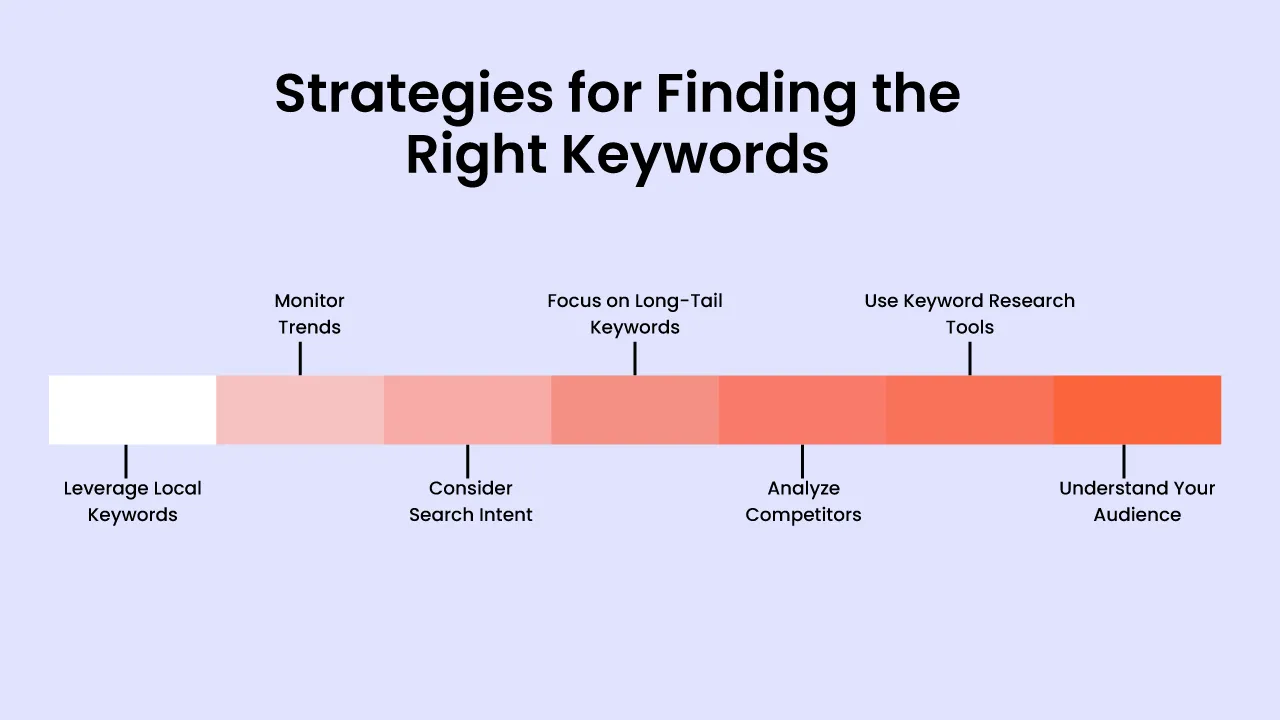
Finding the right keywords is an easy task if you step forward in a strategic way. Here are some best strategies to follow while finding relevant keywords for your business.
- Understand Your Audience: Identify your target audience and the language they use to search for products or services related to your business. Knowing their needs helps in discovering relevant keywords.
- Use Keyword Research Tools: Utilize tools like Google Keyword Planner, SEMrush, Ahrefs, and Ubersuggest to find high-traffic keywords with low competition. These tools offer insights into search volume, keyword difficulty, and trending terms.
- Analyze Competitors: Study the keywords your competitors are ranking for using SEO tools. This gives you ideas on which keywords are driving traffic in your industry and helps you identify gaps.
- Focus on Long-Tail Keywords: Long-tail keywords are longer, more specific phrases. While they have lower search volumes, they often have less competition and a higher conversion rate as they target more specific search queries.
- Consider Search Intent: Understand the intent behind the keywords—whether users are looking for information, making a purchase, or exploring options. Align your keyword choices with user intent to attract the right audience.
- Monitor Trends: Stay updated with current industry trends and seasonal shifts. Tools like Google Trends help identify rising or declining search terms, enabling you to adjust your keyword strategy accordingly.
- Leverage Local Keywords: If you’re targeting a specific geographic area, include local keywords (e.g., “fashion boutique in New York”) to attract regional customers.
On-Page SEO
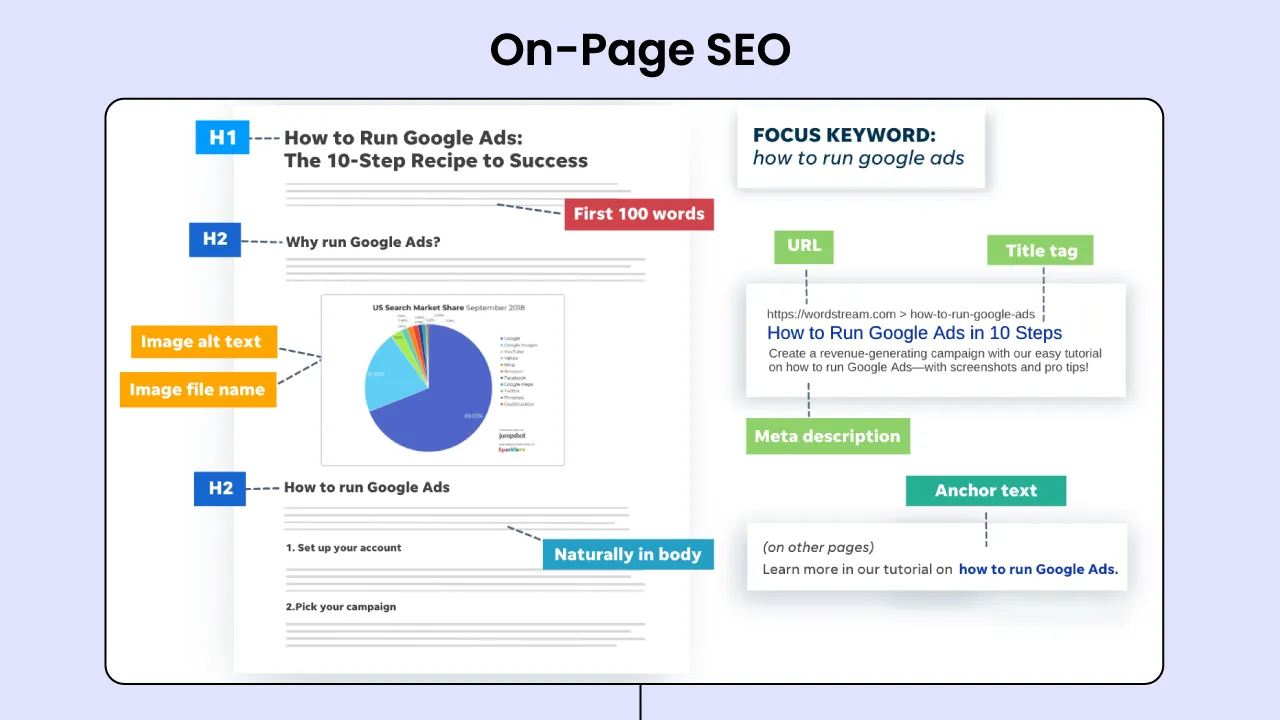
On-page SEO involves optimizing various aspects of a website to improve its visibility in search engine results and attract more organic traffic. This process ensures that both the content and structure of a webpage are aligned with search engine algorithms, making it easier for search engines to understand and rank the page. Some key elements of on-page SEO are:
Title Tags and Meta Descriptions
Title tags and meta descriptions are vital for SEO because they influence how search engines and users perceive your webpage.
Title Tags help search engines understand the page’s content and improve ranking. Best practices include keeping the title between 50-60 characters, using relevant keywords, and making it descriptive yet concise.
Meta Descriptions provide a brief summary under the title in search results, affecting click-through rates. Best practices include keeping them between 150-160 characters, adding primary keywords, and using a compelling call-to-action to engage users.
Header Tags (H1, H2, H3, etc.)
H1 tags should be used for the main title of your page. There should be only one H1 per page, and it should clearly describe the page’s main topic.
H2 tags are used for major subsections under the H1. They help break down content into manageable sections and improve readability.
H3, H4, etc. are used for further sub-sections and details within H2 sections. They create a hierarchy that guides both users and search engines through the content.
Ensure header tags are used hierarchically (H1 > H2 > H3) and include relevant keywords where appropriate. This helps search engines understand the structure of your content and improves the page’s overall SEO.
Content Optimization
Content optimization ensures your webpage is relevant, valuable, and easy to find by both users and search engines. It involves fine-tuning various elements like keyword placement, content length, readability, and multimedia.
Keyword placement
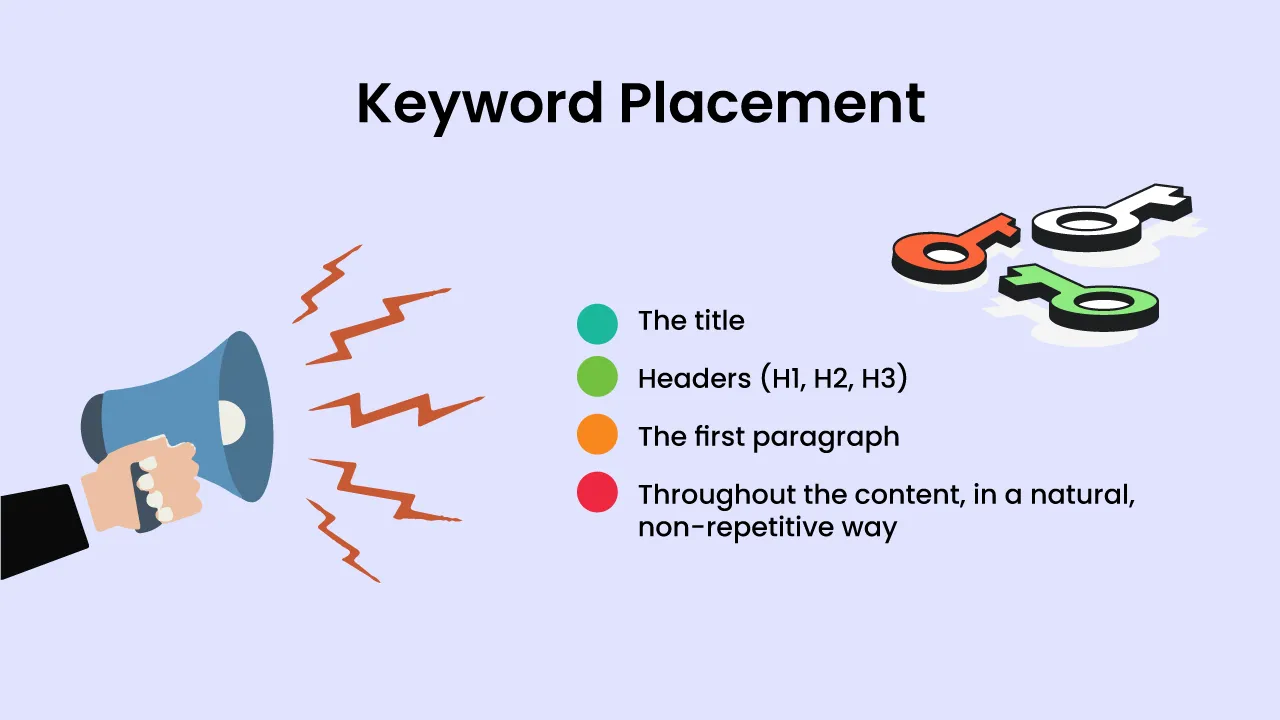
Strategic keyword placement is essential for improving search engine rankings. Keywords should be naturally integrated into:
- The title
- Headers (H1, H2, H3)
- The first paragraph
- Throughout the content, in a natural, non-repetitive way
Avoid keyword stuffing, which can harm readability and SEO performance.
Content length and readability
While there’s no perfect content length, longer, in-depth articles (typically 1,000-2,000 words) tend to rank better in search engines. However, length alone isn’t enough. Content should be easy to read, with short paragraphs, bullet points, and clear formatting to keep users engaged. Tools like the Flesch Reading Ease test can help assess readability.
Multimedia
Multimedia enhances user experience and keeps visitors on your page longer. To optimize images and videos:
- Use descriptive, keyword-rich file names.
- Add alt text to images for accessibility and better SEO.
- Compress media files to improve page load speed.
Multimedia also breaks up text, making content more engaging and visually appealing.
Internal Linking
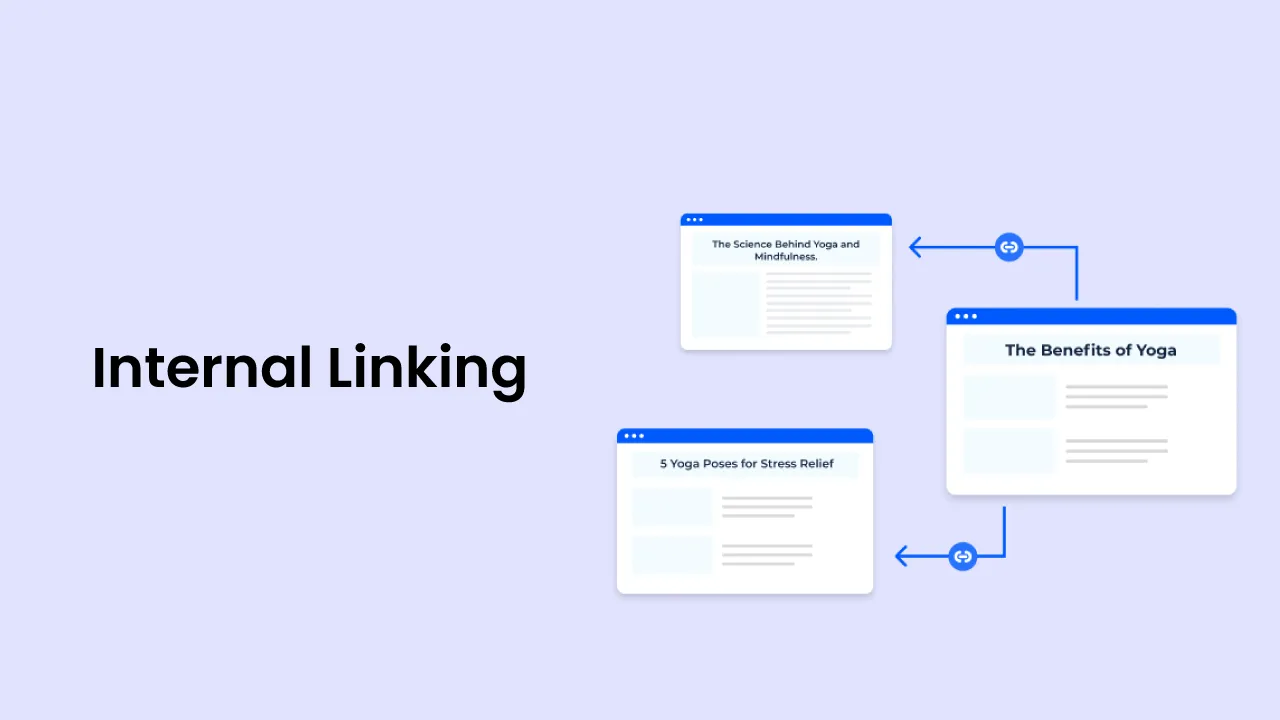
Internal linking is essential for both user experience and search engine optimization. By strategically connecting different pages within your website, you can guide visitors to relevant content, improve search engine rankings, create a clear site structure, and distribute link equity to important pages. This ultimately enhances your website’s overall performance and visibility.
A well-structured internal linking strategy is crucial for both user experience and SEO. To achieve this you should keep followings in your mind:
- Descriptive Anchor Text: Use clear, relevant anchor text for better context.
- Link to Important Pages: Prioritize links to high-value content to boost its visibility.
- Create a Logical Hierarchy: Organize links to reflect your site’s structure and hierarchy.
- Link to Relevant Content: Ensure links lead to pages with related information.
- Regularly Update Links: Check and update internal links to keep them relevant and functional.
URL Structure

A well-organized URL structure is important for both search engine optimization and user experience. Proper URL structure helps search engines understand and index your site effectively, while also making it easier for users to navigate.
- Keep URLs Short and Simple: Shorter URLs are more readable and user-friendly.
- Use Hyphens to Separate Words: Hyphens are preferred over underscores or other characters.
- Include Relevant Keywords: Keywords in URLs help with search engine rankings.
- Avoid Special Characters: Stick to alphanumeric characters and hyphens.
- Maintain Consistency: Reflect the site’s hierarchy for better navigation.
- Use Lowercase Letters: Avoid case sensitivity issues by using lowercase.
Technical SEO
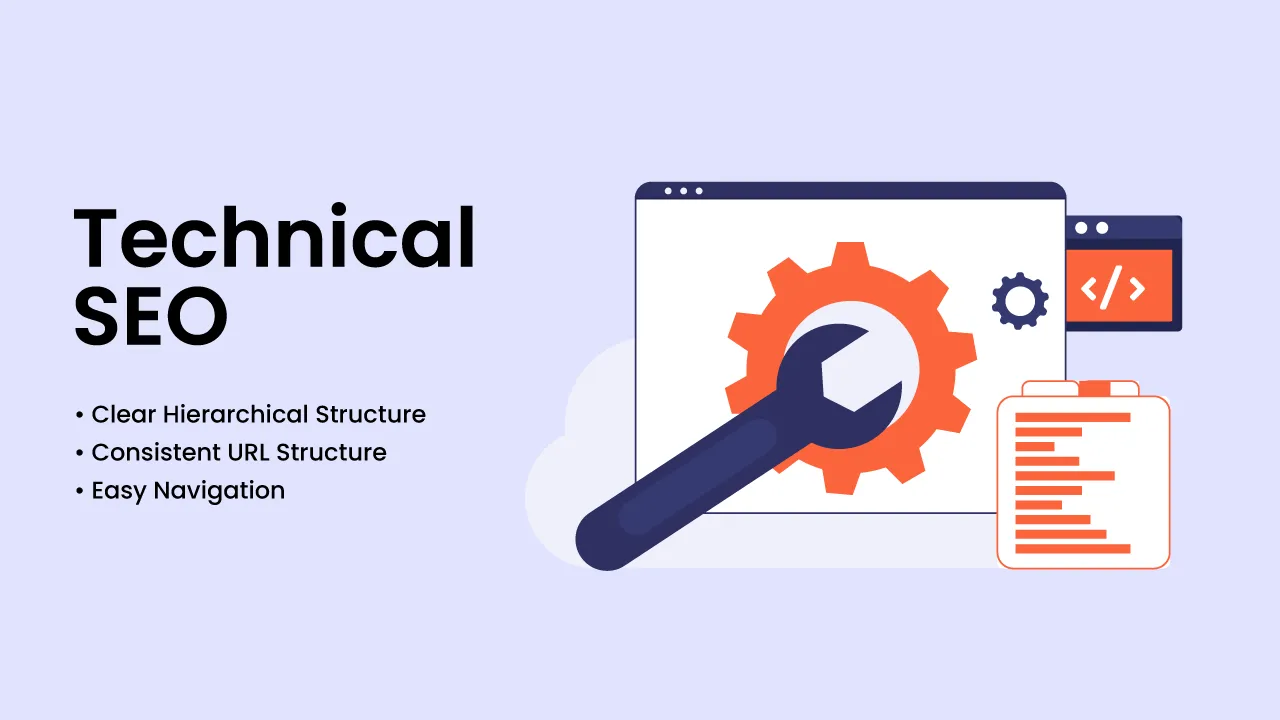
Technical SEO involves optimizing the backend of your website to ensure it meets search engine guidelines and performs efficiently. This aspect of SEO is crucial for improving your site’s visibility and performance. Key elements include optimizing site speed, ensuring proper indexing, and implementing secure connections (HTTPS).
Site Architecture
A clean and well-organized site architecture is essential for both search engines and users. It ensures that search engines can crawl and index your pages effectively, while also providing a seamless navigation experience for users. Key practices include:
- Clear Hierarchical Structure: Use a logical hierarchy to organize your content, which helps search engines understand the relationship between different pages.
- Consistent URL Structure: Maintain a uniform URL format that reflects your site’s organization.
- Easy Navigation: Implement intuitive menus and breadcrumbs to enhance user experience and facilitate easier navigation.
Mobile Optimization

Mobile optimization is crucial as mobile traffic continues to rise. It ensures that your website provides a good user experience on mobile devices, which is essential for retaining visitors and improving search rankings.
When considering mobile optimization, the following approaches should be consider:
- Responsive Design: Ensure your website adapts seamlessly to different screen sizes and orientations. Use responsive design techniques or frameworks like Bootstrap or Foundation to create a fluid layout. Test your website on various devices and screen resolutions to verify its responsiveness.
- Mobile-Specific Content: Consider creating content that is specifically tailored for mobile users. Use shorter paragraphs, bullet points, and concise language. Optimize images and videos for mobile viewing.
- User Experience: Prioritize user experience on mobile devices. Ensure easy navigation and intuitive controls. Avoid excessive scrolling and pop-ups. Make sure your website is touch-friendly and responsive to gestures.
- Mobile-Friendly Indexing: Submit your website to Google’s Mobile-Friendly Test to check its compatibility. Ensure your website is indexed correctly for mobile devices. Use Google Search Console to monitor your website’s mobile performance.
- Mobile-First Indexing: Google has transitioned to a mobile-first indexing approach, meaning it primarily indexes and ranks websites based on their mobile versions. Ensure your mobile site is optimized to provide the best user experience.
Page Speed Optimization
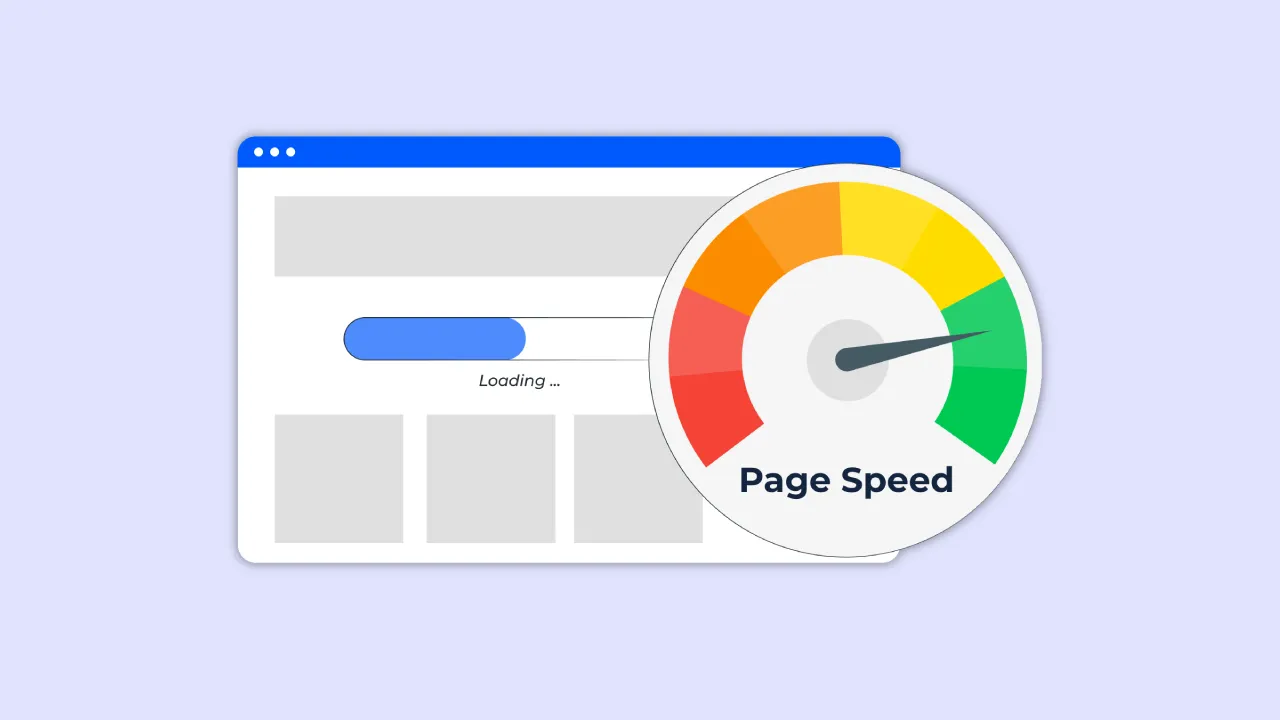
Measuring page speed is the first step in optimizing load times. Various tools can help assess your website’s performance and identify areas for improvement:
- Google PageSpeed Insights: Provides detailed insights into both desktop and mobile performance, along with actionable recommendations.
- GTmetrix: Offers a comprehensive analysis, including recommendations and performance scores.
- Pingdom: Evaluates page speed and provides insights into performance issues and suggestions for improvement.
- WebPageTest: Allows testing from different locations and devices, offering a detailed breakdown of loading times.
To optimize page speed, several key techniques can be implemented. Followings are some obvious techniques, you should follow:
- Optimize Images: Compress and resize images to reduce their file size without sacrificing quality.
- Leverage Browser Caching: Store static resources in a visitor’s browser to speed up subsequent page loads.
- Minify CSS, JavaScript, and HTML: Remove unnecessary characters and code to reduce file sizes and improve load times.
- Enable Compression: Use GZIP or Brotli to compress files before they are sent to the browser.
- Implement a Content Delivery Network (CDN): Distribute content across multiple servers to reduce latency and improve load times.
- Reduce HTTP Requests: Minimize the number of elements on your page that require separate HTTP requests.
XML Sitemaps
An XML sitemap is a file that lists all the important pages on your site, helping search engines discover and index your content more efficiently.It ensures that all pages are crawled and indexed effectively.
To configure your sitemap, generate it and submit it through tools such as Google Search Console or Bing Webmaster Tools. It is important to update your sitemap regularly to reflect any changes on your site, ensuring that search engines have the most current view of your website’s structure and content.
Robots.txt
The robots.txt file directs search engine crawlers on which pages or sections of your site should be crawled or ignored. Its primary purpose is to control access to specific areas, helping prevent the indexing of duplicate or irrelevant content and managing your site’s crawl budget effectively.
To configure robots.txt, create and place the file in the root directory of your site. Use directives such as Disallow to block access to certain pages and Allow to permit access to others. Be cautious to avoid inadvertently blocking important content that you want to be indexed.
Schema Markup
Schema markup is a form of structured data that helps search engines understand the content on your pages. It uses a specific vocabulary (schema.org) to provide additional context about your content.
It enhances search engine understanding and improves the presentation of your site’s information in search results, potentially increasing click-through rates. Examples include rich snippets, such as star ratings, product prices, and event details.
Off-Page SEO

Off-page SEO refers to activities that occur outside of your own website but impact your rankings within search engine results pages (SERPs). It primarily focuses on building authority and relevance through backlinks, social media engagement, and other external signals.
Backlinks
Backlinks, or inbound links, are links from other websites that point to your site. They play a crucial role in SEO for several reasons:
- Authority: Search engines like Google consider backlinks as votes of confidence. High-quality backlinks from authoritative sites can boost your site’s credibility.
- Traffic: Quality backlinks can drive referral traffic, leading to more visitors and potential conversions.
- Ranking Signals: Search engines use backlinks as a key ranking factor. More high-quality backlinks generally correlate with higher rankings in SERPs.
There are several strategies for acquiring high-quality backlinks. The best strategies you should follow are:
- Create Valuable Content: Produce high-quality, informative, and engaging content that naturally attracts links. Think of guides, infographics, or unique research.
- Guest Blogging: Write articles for reputable blogs in your industry. Include a link back to your site in your author bio or within the content (where relevant).
- Broken Link Building: Identify broken links on other websites and offer your content as a replacement. This helps both you and the website owner.
- Skyscraper Technique: Find content that has already attracted backlinks, create something even better, and reach out to those who linked to the original content.
- Engage with Your Community: Participate in forums, comment on blogs, and join social media discussions to build relationships and attract links organically.
Role of social media in SEO
Social media can indirectly impact SEO by increasing visibility and driving traffic. While social signals (likes, shares) are not direct ranking factors, they can lead to:
- Increased Brand Awareness: More people see and engage with your content, increasing the likelihood of backlinks.
- Content Distribution: Social media platforms help distribute your content, reaching broader audiences and potential linkers.
- Building Relationships: Engaging with influencers and followers can lead to collaborations and natural backlink opportunities.
Local SEO
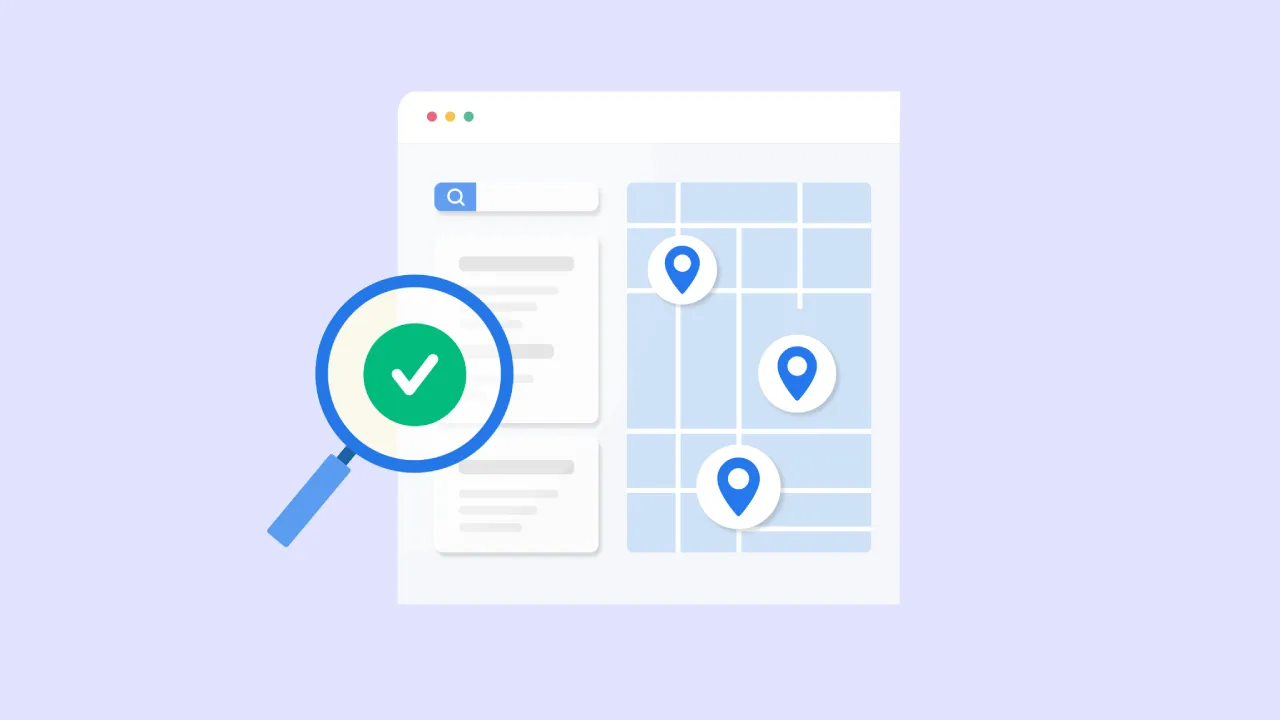
Local SEO optimizes your online presence to attract more business from relevant local searches. This is particularly important for brick-and-mortar businesses.
Optimizing for Local Searches
To improve your local search visibility, start by incorporating location-specific keywords into your content, titles, and meta descriptions. Additionally, ensure that your Name, Address, and Phone number (NAP) are consistent across all platforms. Creating content that is relevant to your local area, such as local events, news, or guides, can further enhance your local SEO efforts.
Google My Business Setup

Claiming and verifying your Google My Business (GMB) listing is essential for appearing in local search results. Once you’ve claimed your listing, complete your profile by filling out all relevant information, including business hours, photos, services, and descriptions. Finally, encourage satisfied customers to leave reviews on your GMB profile, as positive reviews can significantly improve your local ranking.
Influencer Outreach
Building relationships with influencers can significantly enhance your link-building efforts and increase your brand’s exposure. Start by identifying relevant influencers within your niche who have a genuine audience. Engage with them by following their social media accounts, commenting on their posts, and sharing their content to get noticed.
Once you’ve established a rapport, propose mutually beneficial collaborations, such as guest posts, interviews, or co-hosted webinars, where both parties can gain valuable exposure and backlinks. Throughout the process, ensure that your outreach is genuine and provides value, whether through unique insights, content, or other resources, to foster lasting connections.
Content Strategy

A well-defined content strategy is essential for effectively reaching your audience and achieving your marketing goals.
Creating High-Quality Content
To create high-quality content, you must first understand your audience. Conduct research to identify their needs, preferences, and pain points. Tailor your content accordingly, ensuring it resonates with them. Utilize various content formats, such as blogs, infographics, and videos, to keep your messaging dynamic and engaging.
Content Calendar and Planning
Establishing a content calendar is crucial for maintaining consistency and organization. Regular content updates are important, as they signal to search engines and your audience that your site is active and relevant. A strategic plan helps you schedule content around key dates, themes, and promotional events, ensuring a steady flow of fresh material.
Content Promotion
Once your content is created, effective promotion is key to maximizing its reach. Employ various sharing and distribution strategies, such as social media sharing, email newsletters, and collaborations with influencers or other brands. By actively promoting your content, you can drive traffic, engage your audience, and enhance your overall online presence.
Measuring Content Performance

Measuring the performance of your content is crucial for understanding its effectiveness and informing future strategies. You should track the following metrics:
- Traffic: Monitor the number of visitors to your content. Look for page views, unique visitors, and traffic sources to understand where your audience is coming from.
- Engagement: Track metrics such as average time on page, bounce rate, and social shares. High engagement rates indicate that your content resonates with your audience.
- Conversions: Measure how many visitors take desired actions, such as signing up for newsletters, downloading resources, or making purchases. This helps gauge the content’s effectiveness in driving goals.
- SEO Performance: Keep an eye on keyword rankings, organic search traffic, and backlinks generated from your content. These metrics can help assess the content’s impact on your search visibility.
Tools for Analysis

Effective content performance analysis relies on various specialized tools. Some track website visitors, providing insights into page views and traffic sources. Others focus on SEO, helping assess keyword rankings and organic traffic and so on. Some famous tools are:
Google Analytics
Google Analytics is a powerful tool for tracking website traffic and user behavior. It provides insights into page views, unique visitors, and traffic sources, helping you understand how users interact with your content. You can also set up goals to measure conversions, making it easy to evaluate the effectiveness of your content in driving desired actions.
BuzzSumo
BuzzSumo is a content research tool that helps you analyze what types of content perform best in your niche. You can track social shares and engagement metrics to understand which content resonates with audiences. This tool is valuable for identifying trends and finding influencers who might amplify your content reach.
HubSpot
HubSpot is an all-in-one inbound marketing platform that provides tools for content management, SEO, and analytics. It enables businesses to create, optimize, and distribute content while tracking performance across channels. With features like blog creation, email marketing, and social media management, HubSpot streamlines content processes. Its analytics offer insights into visitor behavior and campaign effectiveness, making it a valuable resource for enhancing engagement and driving growth.
SEO Analytics and Reporting
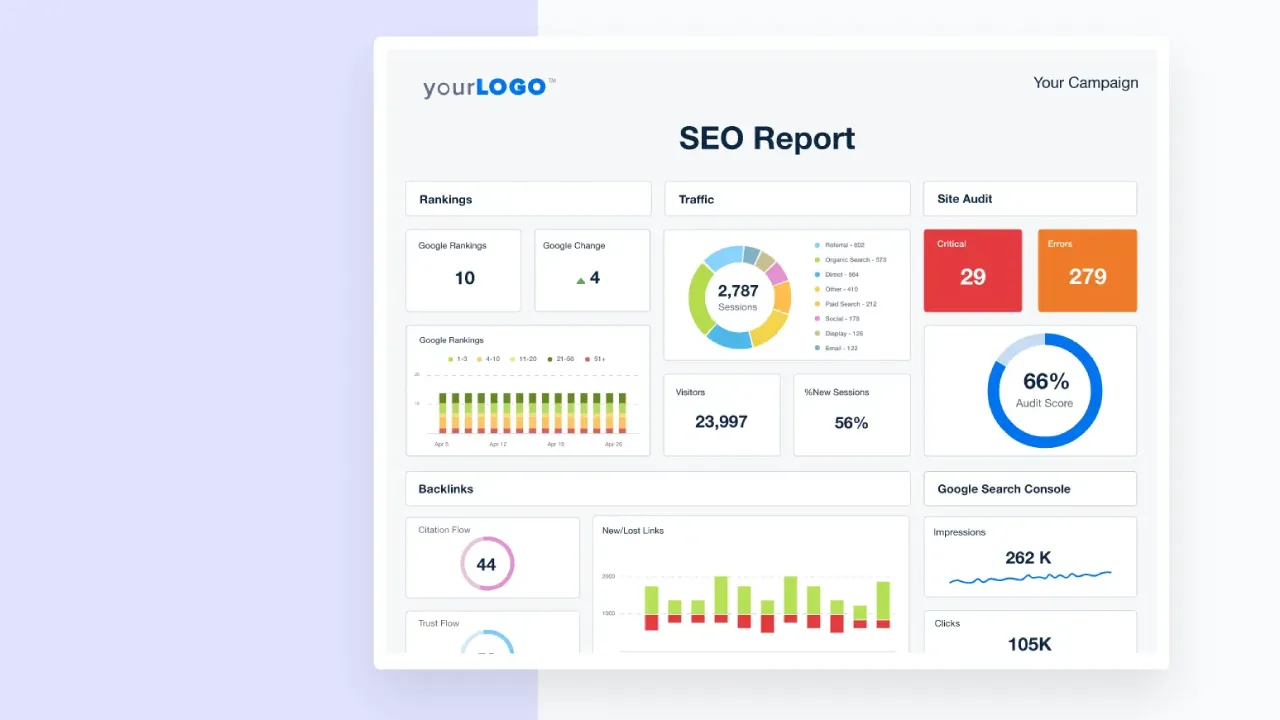
Effective SEO analytics and reporting are crucial for measuring the success of your SEO strategies and identifying areas for improvement.
Key Metrics to Track
- Organic Traffic: Measures the number of visitors coming to your site through organic search results. This metric indicates the effectiveness of your SEO efforts.
- Bounce Rate: The percentage of visitors who leave your site after viewing only one page. A high bounce rate may suggest that your content isn’t engaging or relevant.
- Conversion Rate: The percentage of visitors who complete a desired action (e.g., making a purchase, signing up for a newsletter). This metric helps gauge the effectiveness of your content in driving business goals.
Tools for SEO Analytics
Effective SEO analytics tools provide valuable insights into your website’s performance, helping you optimize your strategy and improve visibility in search results. Here are three key tools to consider:
Google Search Console
Google Search Console is a free tool that helps you monitor and maintain your site’s presence in Google search results. It provides insights into keyword performance, click-through rates, and indexing status. This tool is essential for identifying issues that may affect your site’s visibility and for tracking the effectiveness of your SEO efforts.
Moz
Moz offers a comprehensive suite of SEO tools designed for keyword tracking, backlink analysis, and site audits. It helps you understand your website’s performance in search engines and provides actionable insights to improve your rankings. Moz’s user-friendly interface makes it accessible for both beginners and experienced SEO professionals.
Surfer
Surfer focuses on on-page optimization by analyzing content against top-ranking competitors. It provides detailed insights and recommendations to help you improve your content’s relevance and structure. With Surfer, you can optimize your pages for better search performance by leveraging data-driven strategies.
Interpreting Data
Understanding and applying insights from your data is essential for refining your SEO strategy. Analyze patterns and trends in key metrics like organic traffic, bounce rates, and conversion rates. Use these insights to adjust your content and optimization efforts, ensuring they align with audience needs and search behavior.
Reporting
To create comprehensive SEO reports, compile data from various analytics tools and summarize key metrics, insights, and recommendations. Incorporate visualizations such as charts and graphs to enhance clarity and make the data more digestible. Regular reporting is crucial for communicating progress to stakeholders and informing strategic decisions for ongoing improvements.
Staying Up-to-Date with SEO Trends

Staying current with SEO trends is vital for maintaining and improving your website’s performance. The digital landscape is constantly evolving, and what works today may not be effective tomorrow. To remain competitive, it’s essential to adapt to new developments, understand changes in user behavior, and embrace innovative practices. Here are some key areas to focus on:
Industry Changes
- Algorithm Updates: Search engines frequently update their algorithms, impacting how websites rank. Keeping informed about these changes allows you to adapt your strategies accordingly.
- New SEO Practices: SEO is constantly evolving, with emerging practices and technologies. Staying aware of these developments ensures your tactics remain effective and competitive.
Continuous Learning
Engaging in continuous learning is essential for SEO success. Follow reputable blogs, join forums, and utilize online resources to stay informed about the latest strategies and best practices. Recommended sources include industry blogs, SEO newsletters, and educational platforms that cover various aspects of digital marketing.
Networking with SEO Professionals
Building connections with other SEO professionals can enhance your knowledge and provide valuable insights. Attend conferences and events to network, share experiences, and learn from industry experts (SERP Mentor). Engaging in discussions and workshops can lead to new opportunities and collaborations, keeping you at the forefront of SEO trends.
Conclusion
Throughout this content, we’ve covered the fundamentals of SEO, from understanding how search engines work to optimizing your content and technological infrastructure. We’ve discussed the importance of keyword research, the complexities of on-page SEO, and the important role of technical elements in improving your site’s visibility and usability. We’ve also discussed the importance of local SEO, the impact of user experience, and the need to keep material current. We’ve also talked about the value of employing analytics and reporting tools to make data-driven changes to your SEO approach.
Remember that SEO is a continuous process of learning and change. Keep up with the newest trends and improvements, and continually adopt best practices to keep your website competitive in search engine rankings.
SEO with RankRezz

At Rankrezz, we believe that efficient SEO is the foundation of every successful online business. Our comprehensive approach combines creative concepts with proven strategies to boost your brand’s search engine results. Whether you want worldwide visibility or local significance, our expert team is committed to bringing targeted traffic to your website and improving your online reputation.
We personalize our SEO solutions to your specific business needs by utilizing modern methods and remaining current with industry trends. From in-depth keyword research to refining your Google My Business profile, we ensure your brand reaches the correct audience. With Rankrezz, you’re not simply optimizing for search engines; you’re creating a long-term online strategy that propels your organization ahead.
